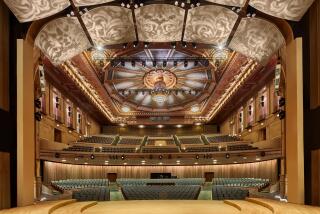QUARTET RETURNS TO SDSU
- Share via
SAN DIEGO — Most resident string quartets are attached either to large universities or to prestigious performance centers in major cities. Forsaking this amenity to be artists in residence in Midland, Tex., has not fazed members of the Thouvenel String Quartet.
“Living in Midland is great for getting our work done; it gives a certain focus, and there are no distractions,” explained the quartet’s violist, Sally Chisholm. More importantly, in the nine years the quartet has made its home in the West Texas oil town of 70,000, it has cultivated a loyal and sophisticated audience for chamber music.
“When Joel Krosnick, cellist of the Juilliard String Quartet, came to Midland to perform with us, he favorably compared our audiences with those in German cities,” added first violinist Eugene Purdue.
All next week the Thouvenel Quartet will be in residence at San Diego State University for the eighth annual San Diego Chamber Music Workshop. Organized by San Diego ophthalmologist-violinist Dr. Ronald Goldman, the workshop is a mecca for musicians from across the country.
According to Goldman, this year’s enrollment is just over 100, with the most participants coming from the San Francisco Bay Area. In addition to the usual intensive individual coaching sessions, Goldman’s workshop includes a chamber orchestra made up of participants and presentations on the Alexander Technique, a relaxation method for performers.
This summer workshop provides for performing musicians what the La Jolla Chamber Music Society’s Summerfest ’86 gives listeners: immersion in the intimate musical idiom they like best. Although the two programs are independent, two Summerfest performers, noted violinist Miriam Fried and Los Angeles Philharmonic principal cellist Ronald Leonard, will give master classes Wednesday and Thursday evenings at 7:30. These classes, held at SDSU’s Smith Recital Hall, are open to the public.
The Thouvenel Quartet has been the San Diego workshop’s resident coaching quartet since 1979, a landmark year for the ensemble, which was formed in 1975 at Indiana University. “We were invited to a festival at UC Santa Barbara in 1979, where we met composer Ernst Krenek,” Purdue said. Having prepared all seven of Krenek’s string quartets for the conference, Thouvenel not only received encouragement and interpretive suggestions from the composer himself, but also was able to convince him to write another quartet for the group’s New York City debut the following year. The Austrian-American composer had written his last string quartet in 1944, so Thouvenel considered it a major coup to get him back to quartet writing after a 37-year hiatus.
If the New York critics had mixed reactions about Krenek’s eighth quartet, they lined up solidly behind Thouvenel as a world- class ensemble. Successful tours to Mexico and Europe followed, but nothing equalled their three-week performance trip to China in the spring of 1985. After President Reagan’s signing of a cultural agreement with China in 1984, Thouvenel was one of the first American performing arts groups to receive an invitation by the Chinese People’s Assn. for Friendship with Foreign Countries.
“The most moving experience was playing in the Shanghai Conservatory for students who had not been allowed to play for 10 years because of the Cultural Revolution,” said Chisholm. All of the quartet’s concerts were broadcast over radio, and the Beijing performance was televised to an audience of 100 million, according to Purdue.
PLaying in China brought the group several surprises. “We found audiences extremely moved by Bartok’s First Quartet. They must know the emotions of loneliness expressed in that quartet,” observed Chisholm. Quartet members had been told of the conservative bent of Chinese audiences, so they expected the Mozart and Schubert quartets on their program to be the most warmly received.
“They also told us that audiences would not be attentive, that they would act like audiences at some outdoor pops concert. But they were so attentive that no one clapped between movements.”
In addition to Purdue and Chisholm, who are married to each other, the quartet includes second violinist Edmund Stein and cellist Keith Robinson II. Robinson replaced Jeffrey Levenson when he left the quartet in 1984 to move to San Diego and join the cello section of the San Diego Symphony. Levenson left his mark on the group in several ways, however, including its unusual name. Thouvenel is the name of the 19th-Century instrument builder who made the cello Levenson was playing when the quartet was formed.
While Thouvenel will not be giving any concerts during this year’s chamber music workshop, the ensemble will give an informal performance of Brahms’ Second String Quartet, Sunday at 8 p.m. in the band room of SDSU’s music building.
More to Read
The biggest entertainment stories
Get our big stories about Hollywood, film, television, music, arts, culture and more right in your inbox as soon as they publish.
You may occasionally receive promotional content from the Los Angeles Times.










